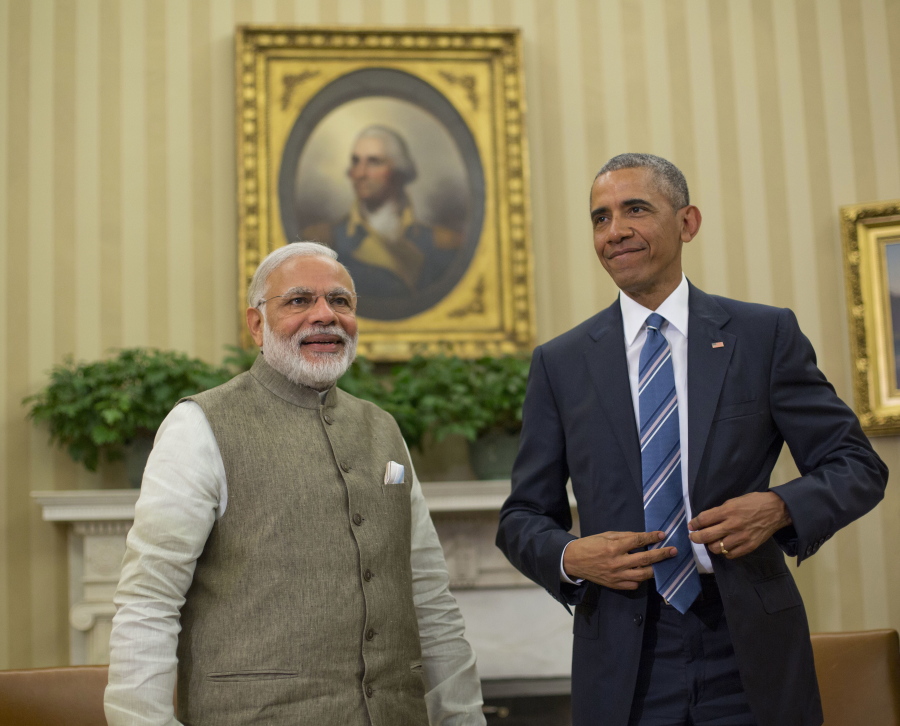WASHINGTON — India will try to join a climate change deal within this year, the Obama administration said Tuesday, as Prime Minister Narendra Modi met President Barack Obama at the White House and the two leaders played up their efforts to cooperate on issues of global concern.
Stressing their “strong bonds,” Obama said the world’s two largest democracies had “joined forces” to bring about the landmark climate agreement that was reached in Paris last December.
“We discussed how we can as quickly as possible bring the Paris agreement into place, how we can make sure that climate financing that’s necessary for India to be able to embark on its bold vision for solar energy and clean energy that Prime Minister Modi has laid out can be accomplished,” Obama said, alongside Modi after their meeting in the Oval Office.
Modi said that the U.S. and India have been cooperating on issues of global concern, including nuclear security, climate change and terrorism. He referred to Obama as “my close friend” and said the two nations would continue working “shoulder to shoulder.”
India is the world’s third-largest carbon emitter among nations, after China and the U.S. The Paris agreement aims to keep the global temperature rise below 2 degrees Celsius (3.6 degrees Fahrenheit) compared with preindustrial times. The agreement enters into force once 55 countries representing at least 55 percent of global emissions have joined it.
In a joint statement, U.S. reaffirmed its commitment to join the climate deal “as soon as possible this year” and India said it shared that objective. Indian Foreign Secretary Subrahmanyam Jaishankar said there were regulatory and legal issues to be addressed. He told reporters that the government was “looking at ways and means” to take the agreement forward.
The U.S., India and dozens of other countries have already signed the deal, the first hurdle in a two-step process, but Modi has been coy about whether India would formally join this year. The U.S. is eager for countries to join quickly because the deal’s carbon-cutting requirements only kick in once a critical mass of polluting nations join. China, Canada, Mexico and Australia have all said they intend to join within this year.
Other joint announcements seemed to illustrate the major challenges in securing concrete progress on climate. Though the two countries said engineering and site development work was starting on six nuclear reactors that U.S.-based Westinghouse Electric Co. wants to build in India, there was no agreement about the major unresolved issue: cost and financing. Instead, the countries said only that they had agreed to finish the contractual arrangements by June 2017.
The U.S. and India also said they’d agreed to try to use a decades-old ozone-protection treaty to phase out hydrofluorocarbons, refrigerants that are potent greenhouse gases, through an amendment that would also provide funds to help poorer countries implement it. But officials said an actual deal to phase out HFCs wouldn’t come until the parties to the treaty meet in October in Rwanda.
The two governments also said they had finalized the text of a defense logistics agreement to make it easier for their militaries to operate together. The U.S. and India share concern about the rise of China, although New Delhi steers clear of a formal alliance with Washington.
This is Modi’s fourth visit to the U.S. since he took office two years ago, and his seventh meeting with Obama. On Wednesday, the Indian leader addresses a joint meeting of Congress.
Modi and Obama seem to have forged a bond. When Obama visited India last year, Modi pulled the president into a bear hug as he stepped off Air Force One. While some analysts question whether that reflects genuine affection, the two leaders have publicly praised each other.
India has long felt slighted by the global powers, seeing itself as a powerful, highly educated country that is all-too-often dismissed for its poverty, dirty streets and the lingering power of its caste system.
The respect is particularly sweet in Washington. Modi was denied a visa to visit the U.S. in 2005, three years after religious riots killed more than 1,000 Muslims in the western state of Gujarat, where he was then the top official. American officials largely avoided contact with him over suspicions that he was involved in the rioting or did not do enough to stop them, until he became prime minister in the 2014 landslide elections.
Modi is on a five-nation tour that has also taken him to Switzerland, Afghanistan and Qatar. After the U.S., he will visit Mexico.



